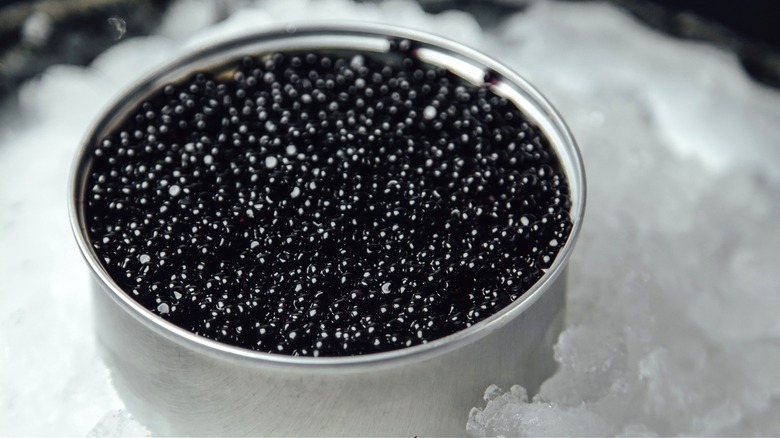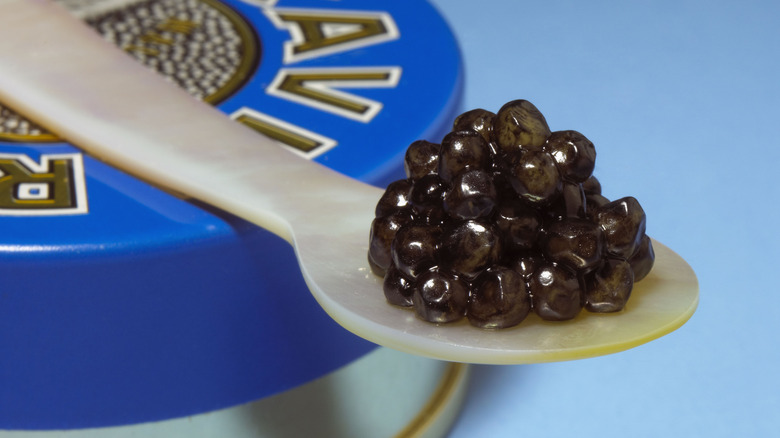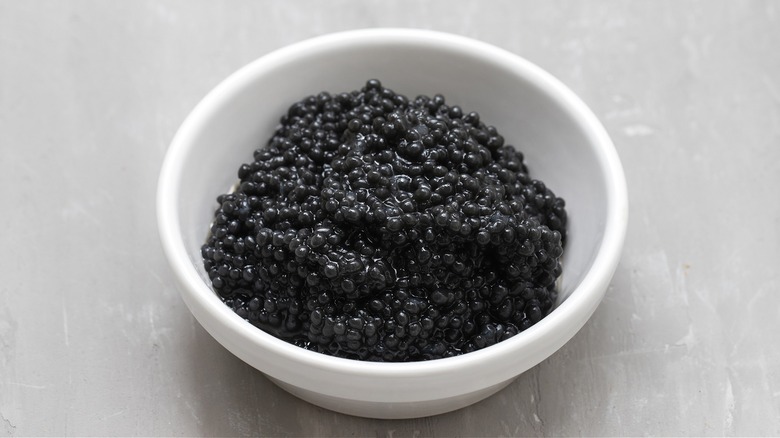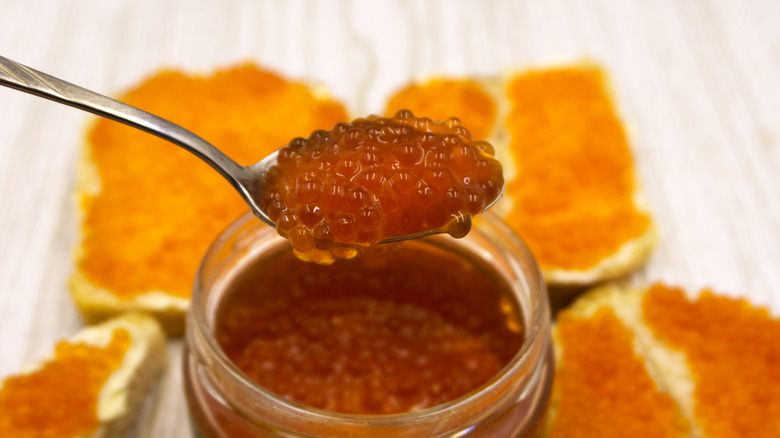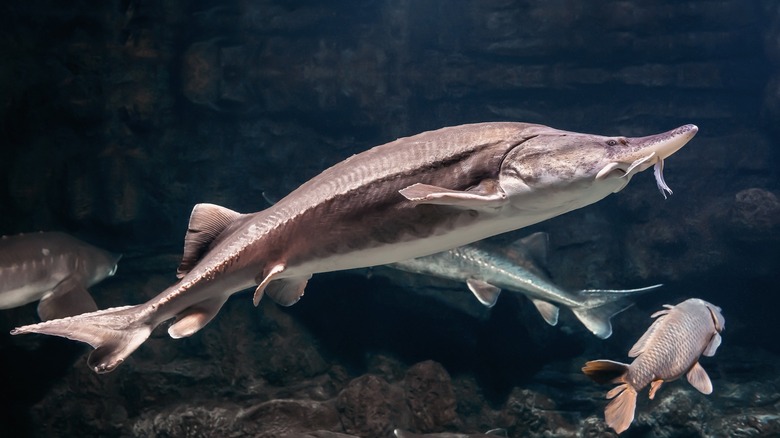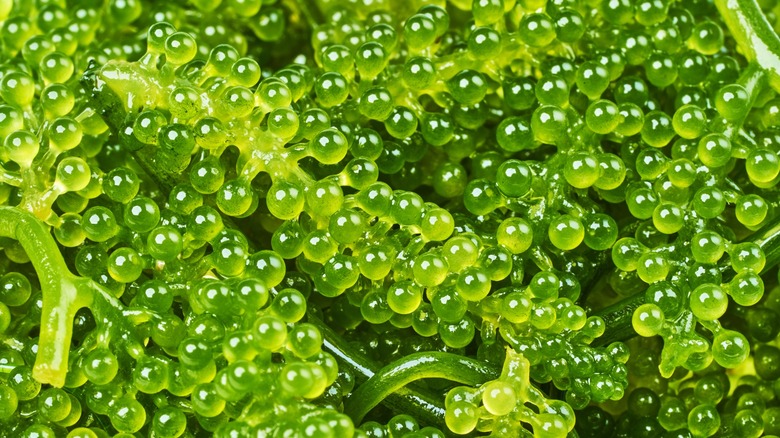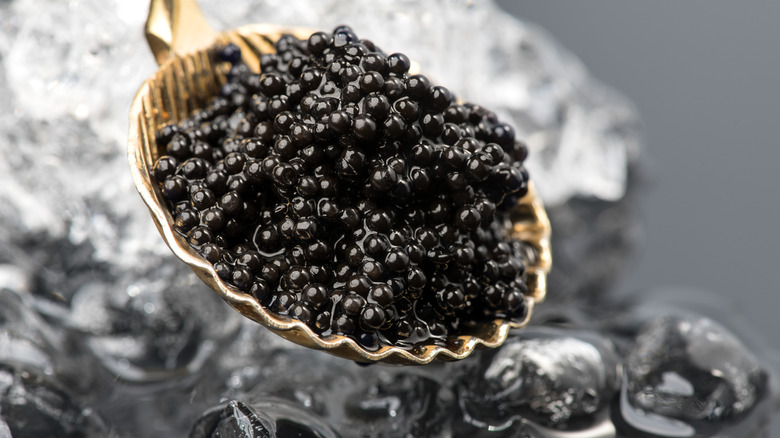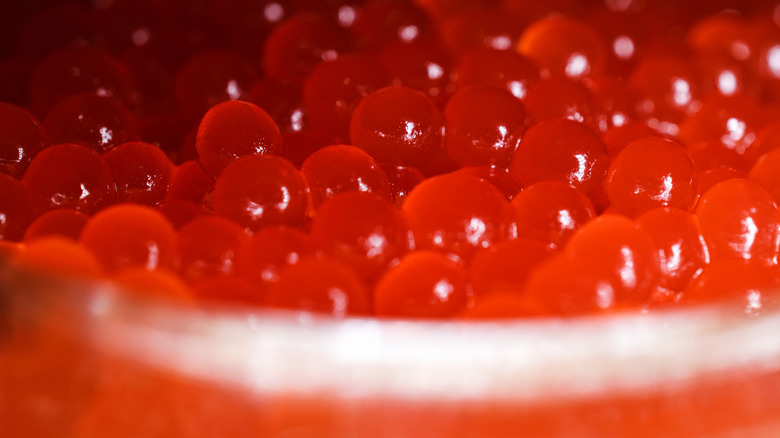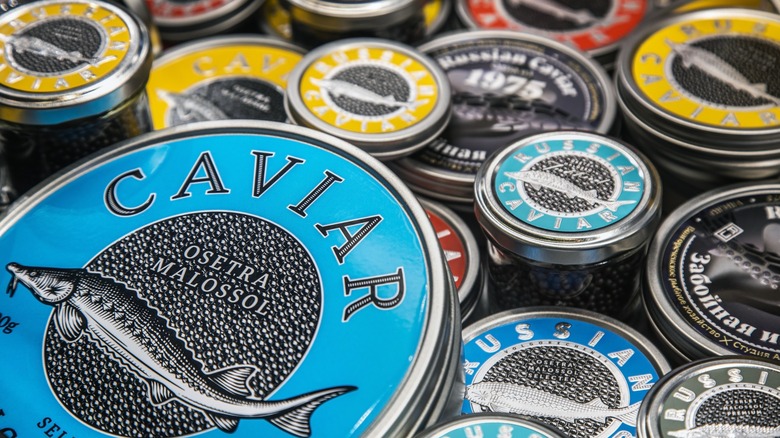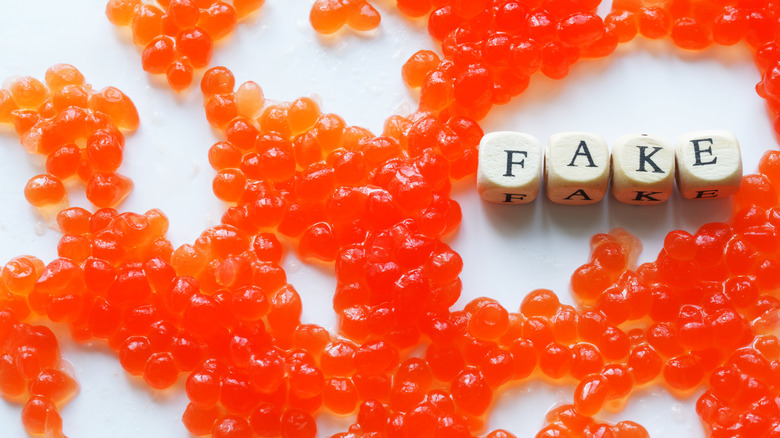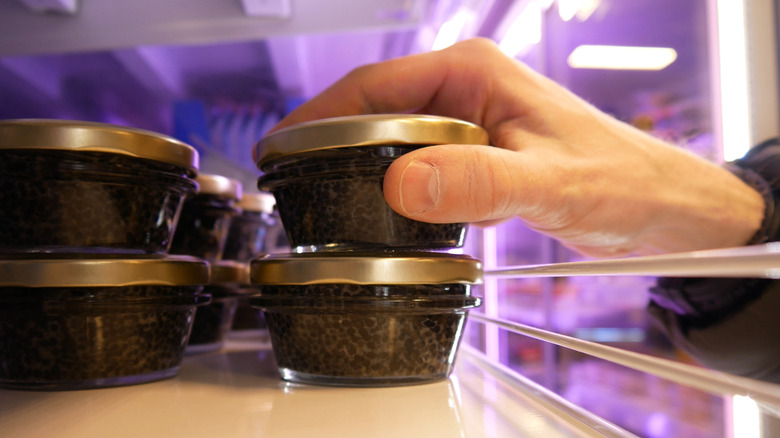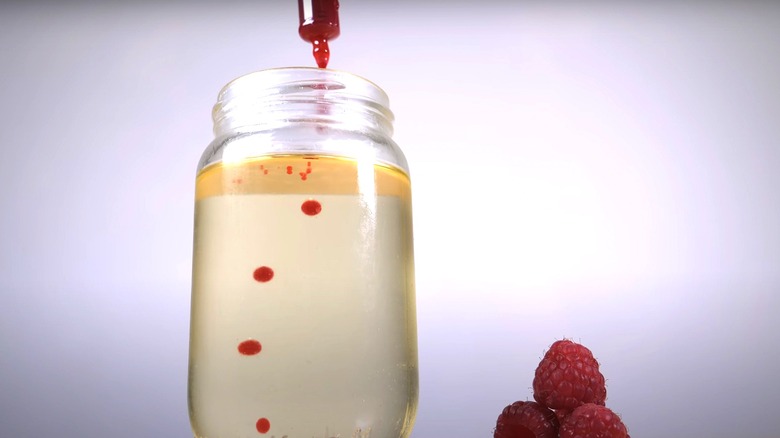Imitation Caviar Vs Real: The Major Differences You Need To Know
Caviar is famous for being an extravagant luxury. Like many other delicacies, it was once considered peasant food, but has since become notoriously expensive and synonymous with wealth and decadence. But, while real caviar is an ostentatious food, there are several much more affordable alternatives out there. The word caviar can be used to refer to several different types of fish eggs (more properly called fish roe). These can vary wildly in price. Imitation caviar, on the other hand, is something else altogether, and may not have anything to do with fish.
I've dabbled in molecular gastronomy, thanks to my scientific education and passion for food. Around the time I was working on my PhD, molecular chefs like Heston Blumenthal were frequently in the limelight, and plenty of enthusiasts were discussing how to use these scientific cooking techniques at home. Near this period, I discovered that white chocolate and caviar go together shockingly well, as well as the food science trick behind making imitation caviar (a surprisingly accessible process called spherification). Imitation caviar and how it's made have come a long way since then, but the basics are still pretty much the same. With this foundation of knowledge, I took a closer look at how imitation caviar compares to the real thing.
What is caviar?
Real caviar is fish roe, specifically fish roe from sturgeon, usually caught in the Black and Caspian Seas. The sturgeon eggs used to make caviar are graded by quality and salt-cured, both to preserve them and to bring out their flavor.
Caviar has a long history, with the earliest records of it found in Ancient Greek writings dating back over 2000 years. The finest caviar was once reserved for nobility and served at the dining tables of Russian Tsars. Times may have changed, but the finest caviar is still exorbitantly costly. The most expensive caviar ever was sold at the frankly ludicrous price of $15,000 per pound.
There are several other types of fish roe sold under the name of caviar, although these are often officially considered "caviar substitutes." A popular affordable choice in this category is lumpfish caviar, which is prepared in much the same way as the real deal, but costs a fraction of the price. This can be found fairly easily in supermarkets, although experts consider it to have a less complex flavor. Similar fish roe can be found in other cuisines from around the world, such as ikura and masago, which are also common sushi ingredients.
What is imitation caviar?
While imitation caviar may look very similar to fish roe, it's most certainly not. Instead, the small pearls of imitation caviar are often made using an ingredient called sodium alginate. This is a polysaccharide (a large molecule with a structure similar to sugar) extracted from seaweed. It's usually used as a vegan gelling agent similar to pectin, which is used to make jams and jellies. If you've eaten certain ice creams or yogurts, you may have already eaten it without realizing it — alginate is used as a stabilizer in these foods.
To make this common type of imitation caviar, you need two key ingredients: Sodium alginate and calcium chloride (a type of salt). Dissolve the calcium chloride into water, and mix the sodium alginate with whatever you want to make into caviar. Then, use an eyedropper to add the alginate mixture into the calcium chloride solution, drop by drop. If you've mixed things properly, the alginate drops will form a skin on the outside, staying perfectly spherical and containing a liquid center, just like real caviar. You can then rinse them off and serve them.
The beauty of this is that it gives a very similar texture to real caviar, but can be made from nearly anything. First-timers often like to experiment with things like fruit juice or soda, but the only real limit is your imagination. Imitation caviar can be made with anything from tomato soup to Angostura bitters.
Imitation caviar is much cheaper
The price tag on great caviar is truly staggering, especially if you order it in a nice restaurant. Here in Paris, where I live, restaurants will serve you about 4½ ounces for around €1300 (over $1,400). Needless to say, my research for writing this article did not extend to fine dining! This is some of the highest-grade caviar available, admittedly, but you'll still be lucky to pay less than a three-figure sum for most restaurant servings of caviar – even smaller servings of cheaper restaurant caviar can cost over $100.
A quick glance at some prices, and you'll see exactly how much cheaper imitation caviar is. Just 1 ounce of Marky's Siberian Sturgeon Royal Caviar costs almost $100. Meanwhile, a jar of Caviart's Award-winning Vegan Caviar costs just under $14 for 3½ ounces. With such a dramatic price difference, it's easy to see why many people would consider imitation caviar at least worth trying.
This isn't to say all caviar has to be expensive though. Recently, fish farmers in China have been attempting to make this delicacy available to all. In fact, the world's largest caviar manufacturer, a company called Kaluga Queen, operates fish farms in Qiandao Lake, where it produces authentic sturgeon caviar. While still not cheap, this company is producing huge amounts of more affordable caviar, making caviar more accessible. This also goes a long way toward solving some of the sustainability problems inherent to producing caviar.
Real caviar has sustainability problems
Real caviar isn't easy to obtain. The eggs need to be harvested from fish, often wild-caught ones, before the eggs are laid or fertilized. Unfortunately, fish don't traditionally survive this process. The result is that the caviar industry has some severe sustainability issues, with fish like the beluga sturgeon being almost hunted to extinction. This became such a concern that the United States banned the import of beluga caviar from the Caspian Sea in 2005 to prevent the fish from being wiped out completely. That ban is still in place, and is unlikely to change anytime soon.
While Chinese sturgeon farmers can help to take the pressure off the beleaguered, wild fish populations of the Black and Caspian seas, the sustainability problems with caviar are likely to only become worse. Global demand for the expensive delicacy is only increasing. In attempts to make the trade more sustainable, there are now no-kill methods to acquire caviar, but these are far from easy. In effect, the only way to collect the sturgeon roe is to perform surgery on the fish. An additional complication is that connoisseurs consider caviar collected this way to have an inferior flavor and texture.
Imitation caviar can be vegan
Imitation caviar often attempts to replicate the taste of the real thing. Some of the flavorings used to give that characteristic oceanic taste include things like oyster extract or sea urchin extract. However, because imitation caviar can be made from virtually anything, it can be made without any animal products at all, creating completely vegan caviar. Seaweed caviar is one type of vegan caviar. Plus, the fact that it's a more sustainable choice, and a better option in terms of animal welfare, makes it an attractive prospect for many people. So attractive, in fact, that entire companies now exist exclusively to produce seaweed caviar.
Another useful thing about imitation caviar is that it sidesteps any uncertainties over religious diets. Strictly speaking, real caviar is neither kosher nor halal. In both Judaism and Islam, seafood is only permissible from creatures with scales. A sturgeon, however, is not a scaled fish, having bony scutes instead. Still, there's some disagreement over whether or not caviar is acceptable as part of these religious diets, and anyone who's uncertain should probably have a word with their rabbi or imam about it. One thing for certain, though, is that most vegan foods (like seaweed caviar) can be eaten without any restrictions.
Real caviar is said to taste better
One thing experts will insist on is that real caviar has a better taste than any of the alternatives out there, either imitation caviar or other types of fish roe. They're probably justified in this opinion too, because it's unlikely caviar would have been considered an expensive delicacy for so long otherwise. Its taste is usually described as buttery, with briny, oceanic notes, and just a hint of nuttiness. Connoisseurs insist that imitation caviar tastes nothing like the real thing, and argue that it shouldn't even have the name of caviar.
Many people, however, may have trouble telling the difference between the flavors of the two, particularly if they're unfamiliar with the real deal. While imitation caviar certainly won't taste exactly the same, it can still be perfectly enjoyable. Opinions, however, are mixed. Some people appreciate how similar imitation caviar tastes to the real thing, while others are unimpressed. Perhaps the biggest difference, though, is not in the taste, but in the texture. The "eggs" in imitation caviar are typically slightly larger than in those in true sturgeon caviar, and have a slightly thicker skin, meaning the imitation variety doesn't quite have the same mouthfeel.
Imitation caviar can taste like anything
Imitation caviar is perhaps at its most interesting when it's not attempting to replicate real caviar. Simply speaking, it will taste like whatever it's made from, and molecular chefs can be exceptionally creative both with what they make imitation caviar from and how they serve it.
One popular choice is to make fruit-flavored imitation caviar. This can be easily made from fruit juice, giving fresh flavors that can work in both savory and sweet dishes. The biggest limitation here is that, using the usual method, imitation caviar can't be made with anything too acidic, so lemon juice caviar is probably out (while there is a workaround to make that possible, it's rather more involved and time-consuming). Some chefs have found that strong flavors work particularly well in their imitation caviar. Making it with espresso, for instance, can make it a very interesting addition to a dessert dish.
In addition to food, cocktail bartenders have also experimented with using imitation caviar in drinks. This can be a fun way to use stronger tasting ingredients, like aromatic bitters, and can add some interest to a drink, altering the flavor as the imitation caviar pearls burst. Those who prefer their drinks without alcohol can also enjoy the fun. Things like Mayde's Bursting Boba Pearls (which come in flavors like strawberry and mango) are made in the exact same way as imitation caviar, and can add a fun twist to your bubble tea.
Real caviar is easier to buy
A drawback to imitation caviar is that it's simply not as easy to find for sale as real caviar or its cheaper fish roe substitutes. True sturgeon caviar can be surprisingly easy to find, although the premium grade A caviar may still prove elusive. It even can be found on sale in some supermarkets –as long as you can afford the steep price tag. For those who prefer groceries that cost under $100, caviar substitutes made from other types of fish roe are easy to find in stores. Options like Romanoff Black Lumpfish Caviar can be bought online for under $5 per ounce.
While not as prolific, imitation caviar is becoming increasingly easy to find. Different versions of it can be bought from a few manufacturers, but it's still not as readily available. It can sometimes be found in supermarkets, but it might be easiest to get by ordering it online. A budget option like Pacific Secrets Red Vegan Caviar costs just over $2 per ounce, making it among the cheapest ways to enjoy imitation caviar.
For those who want to try something a little different, there are some high-end imitation caviars out there too, like TartufLanghe Truffle Caviar. This is made with black winter truffle juice — though those on animal-free diets should be aware that it also contains squid ink.
Imitation caviar may be healthier
One undeniable fact about real caviar is that it's very salty. This really can't be avoided — caviar is made by salt-curing sturgeon roe, meaning that all caviar is loaded with sodium. This isn't necessarily a deal-breaker though, considering caviar is usually eaten in very small amounts at a time (usually no more than a spoonful or two), Even so, people with high blood pressure or heart conditions should be wary. Aside from the salt, caviar is quite nutritious, being rich in vitamins A, E, and B12, as well as choline, which your brain needs to regulate memory.
Nutritional information on imitation caviar is much less straightforward. It will have all the nutrients from whatever it's made with, which means that the specifics can vary. It's best to check the label on what you're buying. Typically though, enthusiasts consider it a healthier choice. Imitation caviar tends to be lower in sodium and may contain no fats at all.
Real caviar doesn't last as long
Real caviar is a delicate and extremely perishable food. A sealed jar can stay fresh for a few weeks, but once opened, it will only be good for a day or two. To keep it at its best, caviar must be kept cold — but not too cold, because freezing it can ruin its flavor and texture. Sealed jars of caviar can be frozen and kept in the freezer for up to a year. Experts recommend against doing this, though, because freezing will severely damage the quality of it. This is one food that should be eaten as fresh as possible.
While real caviar can't be kept for long, shelf life is one way that imitation caviar really shines. Commercially available imitation caviar can stay fresh for three months after being opened, or can be stored for up to three years while sealed! That's convenient, considering imitation caviar is cheaper, so you're likely to find it on sale in larger jars.
Imitation caviar can be made at home
In addition to buying the imitation caviar itself, those who like to be adventurous in the kitchen may want to consider buying a kit to make their own. These take a little skill to use, but don't be intimidated. If you can learn how to bake a cake, then you can certainly learn how to make imitation caviar. Commercially available molecular gastronomy kits should include everything you need, like the Kitchen Alchemy Molecular Gastronomy Spherification Kit which even includes access to a short online course teaching you how to use it.
The big benefit to making imitation caviar yourself is that it gives you the freedom to experiment and get creative with your recipes, both savory and sweet. The only thing to be careful about is that your homemade caviar won't keep for very long. After you've made it, there's no easy way to stop the chemical reaction, so it just keeps on going. This means that if you don't serve it immediately, you'll end up with balls of solid gel, which lack that satisfying popping sensation. They'll still be perfectly fine to eat, but won't have the same texture. It's best to make the imitation caviar the last thing you prepare before plating up your meal.
Typically, homemade imitation caviar will only keep a caviar-like texture for up to half an hour after being made. As long as you don't mind the change in texture though, it'll still be good to eat afterward, and can be kept for a day or two in the fridge, in a sealed container.
